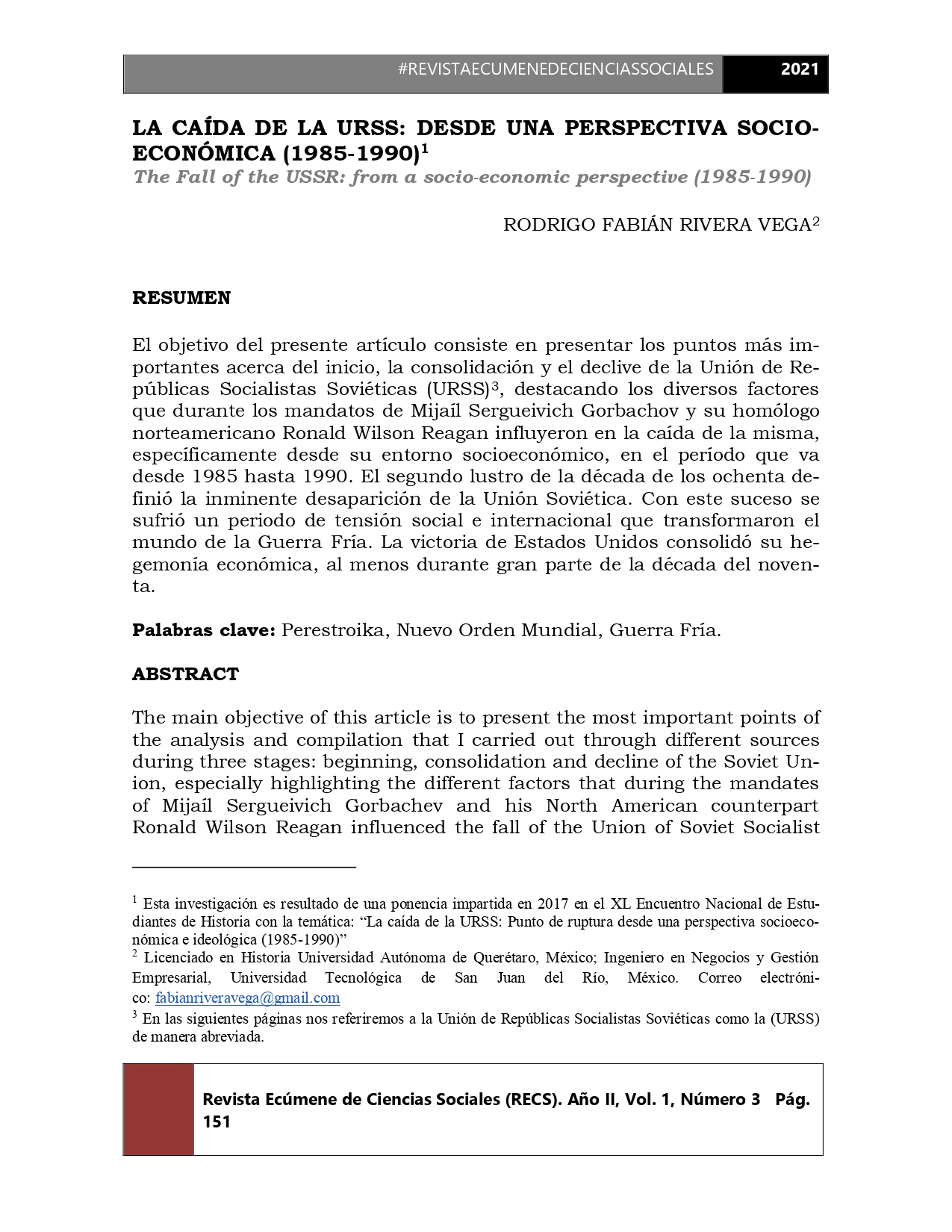Abstract
The main objective of this article is to present the most important points of the analysis and compilation that I carried out through different sources during three stages: beginning, consolidation and decline of the Soviet Union, especially highlighting the different factors that during the mandates of Mijaíl Sergueivich Gorbachev and his North American counterpart
Ronald Wilson Reagan influenced the fall of the Union of Soviet SocialistRepublics (USSR) making an approach from their socioeconomic environment , in the period from 1985 to 1990, which will inevitably define the
end of the Cold War. It constitutes an attempt to understand in greater depth, such a particular period of the Cold War since its inception with the formation of the "new world order", where at the end of the Second World
War (1945), there would be socio-economic, demographic and ideological changes. Likewise, the second half of the eighties would define the imminent disappearance of the Soviet Union. With this event there would be an inevitable collapse, a social and international tension that would give rise to a new change in the world; giving hegemony to the United States until
today.
References
Arne Odd, La Guerra Fría una historia mundial. España: Galaxia Gutenberg, 2018.
Boukovski, Vladimir. “Los Infortunios de la Perestroika”, en URSS De la utopía al desastre. México: Editorial Diana, 1992.
Chomsky, Noam. El miedo a la democracia. Barcelona: Editorial Crítica, 2002.
Gorbachov, Mijaíl. “No veo otro camino que la democracia”, en El Golpe de Agosto: la verdad y sus consecuencias. México: Editorial Diana, 1992.
Hobsbawm, Eric. “Adiós a todo eso” en Después de la Caída. Barcelona: Editorial Crítica, 1993.
Hobsbawm, Eric. "El siglo XX", Barcelona: Editorial Crítica, 1998.
Hobsbawm, Eric.“Guerra y paz en el siglo XXI”, Barcelona: Editorial Crítica, 2007.
Leffler, Melvyn. La guerra después de la guerra: Estados Unidos, la Unión Soviética y la Guerra Fría. Barcelona: Editorial Crítica, 2007.
Mc Mahon, Robert, “La Guerra Fría: una breve introducción” España: Editorial, Alianza, 2003.
Meyer, Jean. “Presentación”, en Perestroika I, México: Fondo de Cultura Económica, 1991.
Pazos, Luis. Del Socialismo al Mercado las enseñanzas del siglo. México: Editorial Diana, 1991.
Powaski, Ronald. LA GUERRA FRÍA Estados Unidos y la Unión Soviética, 1917-1991. Barcelona: Editorial Crítica, 2000.
Procacci, Giuliano. “El fracaso de la perestroika” en Nueva Historia General del siglo XX Barcelona: Editorial Crítica, 2005.
Serbeto, Enrique y Quesada González, Alfonso. “El fin de la URSS”. Historia y Vida, septiembre, 2016.
Spanier, John Reagan y la Segunda Guerra Fría: Revitalizando la capacidad militar y económica norteamericana en La política exterior norteamericana después de la segunda guerra mundial Argentina, Grupo Editor Latinoamericano, 1991.
Thomson, David. “El mundo contemporáneo 1945 a 1968”, en Historia Mundial de 1914 a 1968. México: Fondo de Cultura Económica, 2014.
Vladislav Zubok, La salida de la vieja guardia 1980-1987, en Un Imperio Fallido: La Unión Soviética durante la Guerra Fría. España, Editorial Crítica, 2011.

This work is licensed under a Creative Commons Attribution-NonCommercial-ShareAlike 4.0 International License.

